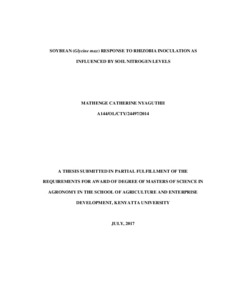| dc.contributor.author | Nyaguthii, M.C. |
| dc.date.accessioned | 2022-06-16T13:33:26Z |
| dc.date.available | 2022-06-16T13:33:26Z |
| dc.date.issued | 2017-05 |
| dc.identifier.citation | Nyaguthii, M.C. (2017). Soybean (Glycine max) response to rhizobia inoculation as influenced by soil nitrogen levels. Suba, Kenya: Kenyatta University, (95 p.). |
| dc.identifier.uri | https://hdl.handle.net/20.500.12478/7511 |
| dc.description.abstract | Inoculation of soybean (Glycine max) is an efficient and convenient way of introducing rhizobia to soil and subsequently the rhizosphere of the crop. However, its full potential in sub-Saharan Africa is yet to be realized due to effects of varying soil limiting conditions. Critical levels of nitrogen (N) below and above which response is not guaranteed are unknown. The objective of the study was to determine the critical range of N outside which response to inoculation is hindered. Below the lower limit, an adequate starter N would be required, while above the upper limit, inoculation would not be effective. A greenhouse experiment was set up with sixty soils with a varying range of total N (%) and organic carbon ≤ 2.1 %. The experiment setup was a Complete Randomized Design (CRD) with and without inoculation replicated three times. A second greenhouse experiment with two soils selected based on the first experiment was used (with 0.06 % N and 0.08 % N). A complete randomized design was used with three replicates and five rates of an organic N source (i.e. 0, 2.5, 5, 7.5 and 10 t Phymyx ha-1) for each soil N level, with and without inoculation to assess whether the organic amendment could improve the response to inoculation within the adequate range of N. A field experiment was set to validate the 2ndgreenhouse experiment results under field conditions. A split plot arrangement in a randomized complete block design (RCBD) design full factorial with three replicates for the two sites was set up. The main plot as Sympal (contains phosphorus, potassium, Sulphur, calcium, magnesium, and zinc) applied at a rate of 30 kg P ha-1and the sub-plots had Phymyx at 5 levels with and without inoculation. Soybean variety TGx1740-2F was inoculated with Bradyrhizobium japonicum strain 532c. In the first greenhouse trial, it was demonstrated that soybean response to inoculation was significantly affected by soil fertility based on nodule fresh weight and shoot biomass, but on average the two parameters were improved by inoculation with Legumefix (p<0.05). The soil with 0.17 % N gave the highest mean weight of 27.89 g plant-1 while soils of 0.029 % N produced the lowest mean weight of 0.17 g plant-1 for inoculated soils. In the second greenhouse trial, nodule fresh weight and biomass N uptake were enhanced by application of Phymyx (p<0.05. highest shoot dry weight and nodules fresh weight were observed between 0.16 % and 0.17 % nitrogen for both non-amended and after soil amendment. Nitrogen levels above 0.17 % N suppressed the nodulation and resulted in reduced shoot dry weight per plant. A 0.17 % N was the potential threshold level above which soybean response to inoculation would not be achieved in clay soils. In field conditions, soybean grain yields after inoculation were better at 0.08 % N than at 0.06 % N, which confirmed the effect of the soil type found in the first greenhouse conditions and reflected the differences in the initial soil fertility level at the two sites. Yields were also significantly improved by application of Phymyx from 5t of Phymyx ha-1. It was concluded that soybean nodulation in low fertility soils would not be suppressed by starter N in the form of organic amendments like Phymyx up to 7.5 t Phymyx ha-1 and that productivity traits including yields of rhizobia-inoculated soybean in such soils could be improved by co-application of organic amendment and a legume-specific fertilizer blend. |
| dc.format.extent | 95 p. |
| dc.language.iso | en |
| dc.publisher | Suba, Kenya |
| dc.subject | Soybeans |
| dc.subject | Glycine Max |
| dc.subject | Grain Legumes |
| dc.subject | Rhizosphere |
| dc.subject | Greenhouses |
| dc.subject | Productivity |
| dc.title | Soybean (Glycine max) response to rhizobia inoculation as influenced by soil nitrogen levels |
| dc.type | Thesis |
| cg.contributor.crp | Grain Legumes |
| cg.contributor.affiliation | Kenyatta University |
| cg.contributor.affiliation | International Institute of Tropical Agriculture |
| cg.coverage.region | Africa |
| cg.coverage.region | East Africa |
| cg.coverage.country | Kenya |
| cg.identifier.bibtexciteid | NYAGUTHII:2017 |
| cg.authorship.types | CGIAR and developing country institute |
| cg.iitasubject | Agronomy |
| cg.iitasubject | Grain Legumes |
| cg.iitasubject | Plant Breeding |
| cg.iitasubject | Plant Production |
| cg.iitasubject | Soybean |
| cg.notes | IITA supervisors: Dr. Masso, C. and Thuita, M. |
| cg.publicationplace | Kenyatta University |
| cg.accessibilitystatus | Limited Access |
| cg.reviewstatus | Internal Review |
| cg.usagerightslicense | Copyrighted; all rights reserved |
| cg.targetaudience | Scientists |
| cg.futureupdate.required | No |

